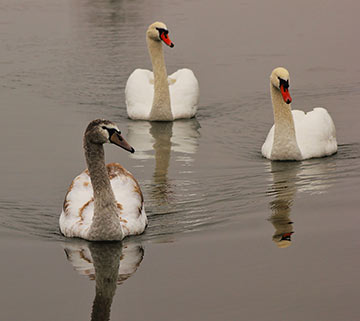Animals grieve just as people do
UK – When a young swan was trapped in a canal lock in Leicester last week, its parents seemed devastated. The adult swans stayed close by for two days, visibly distressed as they tried to coax the cygnet out. An onlooker said: “I’m a parent myself and I know how anxious they must have been, knowing their son or daughter was stuck.”
It’s a charming story, but is it right to make comparisons like this? Were the swans really experiencing similar emotions to human parents, or is this naive anthropomorphism?
Until the Eighties, the idea that animals might have feelings like humans was regarded as laughable. The reactions of animals were thought to be a series of automatic reflexes in response to environmental stimuli. While it was accepted that animals experienced basic feelings like pain, fear and anger, if anyone suggested that they shared the same type of complex emotions as humans, such as love or grief, they were dismissed as sentimental and deluded.
But sophisticated brain-imaging techniques have since demonstrated that humans form emotions in the primitive parts of the brain, such as the limbic system, that we share with all mammals. The same neurotransmitter chemicals, such as dopamine and endorphins, are also identical across different species. If the anatomy, physiology and biochemistry are the same, why should the feeling experienced be any different?
In 2012, the world’s leading scientists on the subject published the Cambridge Declaration on Consciousness in Non-Human Animals, which agreed that animals experience moment-to-moment consciousness, just like humans. The key differences between human and animal brains, mainly found in the frontal cortex, allow humans to think, plan and reflect, but other than these aspects, animal consciousness is now thought to be surprisingly similar to our own. So, yes, animals can care for each other in a way that resembles “love”, they may become distressed if a companion is in trouble, and they often display signs of grief after a death.
In my job as a vet, I have come across countless examples of pets showing feelings for each other. Long-term animal companions – both dogs and cats – often become fond of each other, playing together, grooming one another, and curling up to sleep, bodies entwined. There are hundreds of videos on YouTube showing animal friendships, including unlikely pairings such as Great Danes and kittens, cats and pigs, and dogs and ducklings. Animals – like humans – don’t always get on well together, and there are just as many stories of pets ignoring each other or, worse, actively disliking and attacking particular individuals.
Pets also show variable reactions when a companion dies. While some animals seem depressed and withdrawn, others continue as if nothing has happened. Some even become more animated and active, as if relieved that the deceased animal has moved on.
Vets are often asked how to help animals suffering bereavement. Some now suggest that pets should be allowed to view the body of a recently deceased companion, and though animals do not react in the same respectful way as adult humans, this may help with some sort of acceptance of the loss. Otherwise, advice for bereaved pets is similar to that offered to grieving humans: take up a hobby and find new friends. This could mean new toys for a cat, or walking your dog somewhere different. Sometimes, a new housemate can be a good answer.
Anthropomorphism hasn’t disappeared, by the way. It is still naive, sentimental and deluded to think that animals always have feelings just like humans. But here’s the new thing: they sometimes do.
Originally published by the Telegraph, author Pete Wedderburn.


Leave a Comment
You must be logged in to post a comment.